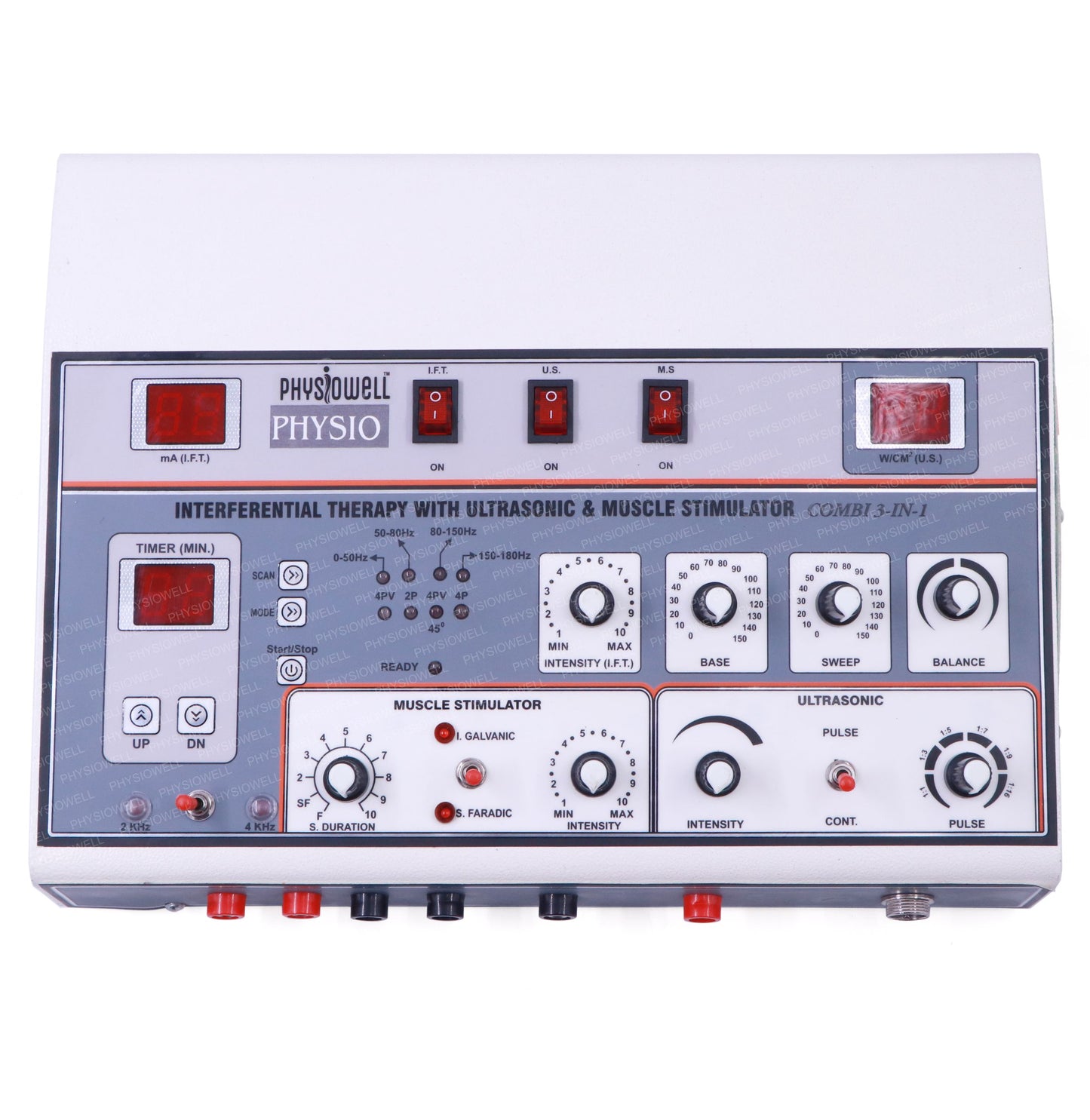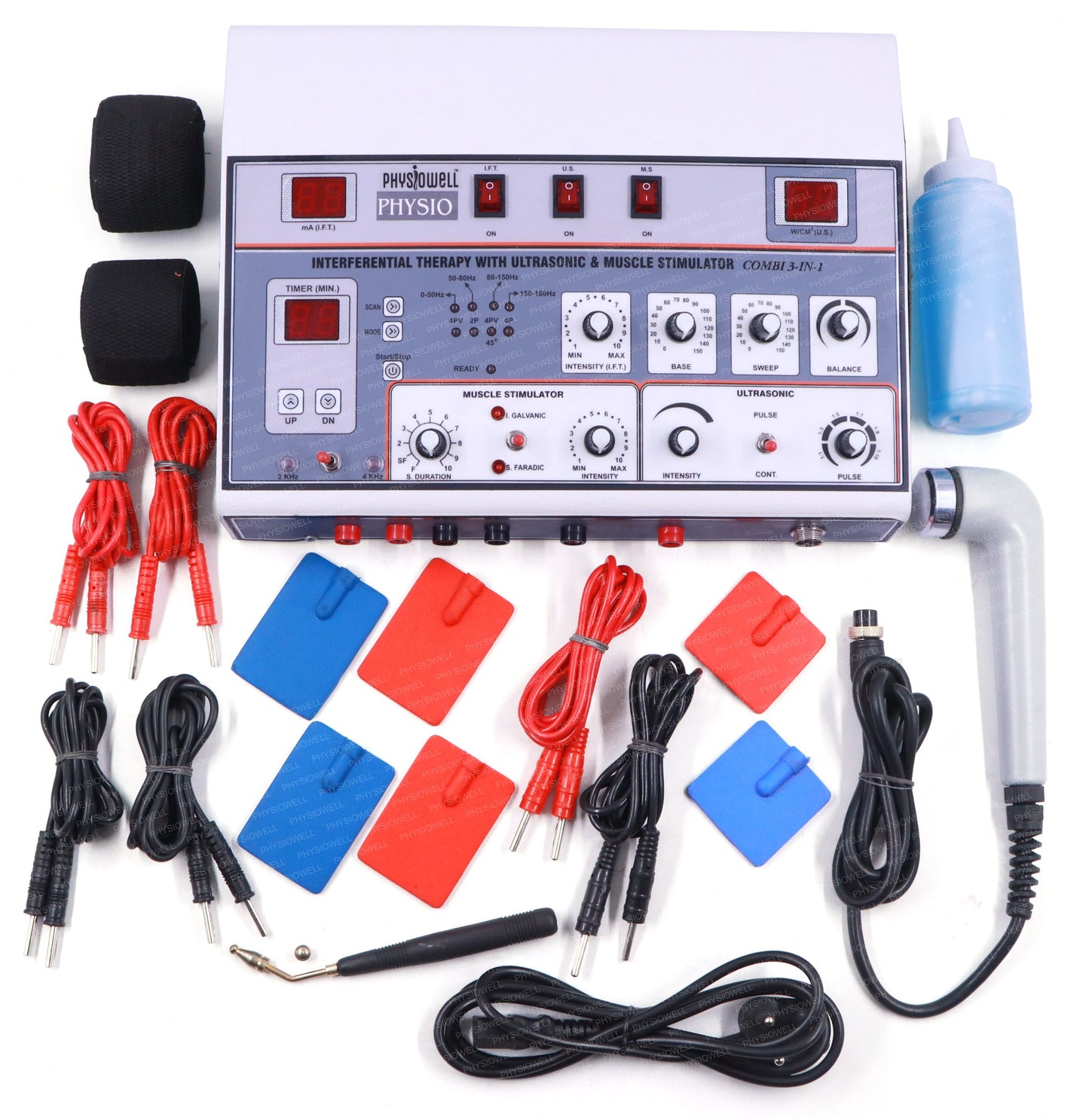Physiowell
3 IN 1 Manual (IFT+ Ultrasonic + Muscle Stimulator)
3 IN 1 Manual (IFT+ Ultrasonic + Muscle Stimulator)
Couldn't load pickup availability
PHYSIOWELL IFT + US+ MS COMBO

PHYSIOWELL IFT + US+ MS COMBO
WHAT IS INTERFERENTIAL THERAPY (IFT)?
IFT which stands for Interferential Therapy is one of the types of electrotherapy used for the management of pain. The principle of interferential therapy is to cause two medium-frequency currents of slightly different frequencies to interfere with one another. For example, if circuit A carries a current with a frequency of 4000Hz and Circuit B carries a current with a frequency of 3980 Hz, then the low frequency produced will be 20 Hz and this frequency is very useful in pain modulation. A new low-frequency current known as the beat frequency is equal to the difference in frequencies between the two medium-frequency currents produced in the tissues at the point where the two currents cross.
WHAT ARE THE CONDITIONS OR SYMPTOMS TREATED BY INTERFERENTIAL THERAPY (IFT)?
IFT works in a special way as it uses interferential rather than normal stimulation. The main clinical applications for which IFT appears to be used are as:
- Pain Relief in conditions such as causalgia, herpes zoster, and neuralgia.
- Cervical Pain.
- Joint pain
- Muscular Pain.
- Frozen shoulder.
- Disc herniation.
- Spinal canal stenosis.
- Muscle Stimulation - prevent muscle wastage, re-education, maintain range of motion stress incontinence
- Reduction of Edema (Condition involving the excess collection of watery fluid in the cavities or tissues)
- Muscle injuries
- Ligamentous injuries
PHYSIOWELL IFT + US+ MS COMBO

PHYSIOWELL IFT + US+ MS COMBO
WHAT IS ULTRASOUND THERAPY OR THERAPEUTIC ULTRASOUND?
This therapy involves the application of Ultrasound waves above the range of human hearing in order to treat various types of injuries. The application of Ultrasound Therapy helps in increasing the blood flow of a localized area in order to reduce the swelling and inflammation in that area. It is also used to enhance the healing of a bone fracture.
The most common conditions that can be treated using Ultrasound therapy are:
It is a general term that is used to define the inflammation of the tendon tissue that connects the muscle to the bone. This is the most common cause of soft-tissue pain. It can occur at any age but it is more common in adults who do a lot of sports. Old-age people are also prone to it as the tendons tend to lose their elasticity and become weaker with age. Its common types are:
- Tennis Elbow
- Golfer's Elbow
- Jumper's Knee
- Ganglion
Other conditions that can be treated with Therapeutic Ultrasound are:
- Joint Swelling
- Muscle spasm
- Pain
- Varicose ulcers
- Pressure sores
- Frozen shoulder
PHYSIOWELL IFT + US+ MS COMBO

SHOULDER PAIN RELIEF
Ultrasound therapy may be potentially helpful in treating pain associated with several conditions: Neck pain3. Chronic back pain4. Myofascial pain syndrome, which describes recurring pain and spasms in an area of the body. Therapeutic ultrasound may reduce the intensity of pain more than sham or no treatment, and it is a safe treatment.

KNEE PAIN RELIEF
Ultrasound therapy may be potentially helpful in treating pain associated with several conditions: Neck pain3. Chronic back pain4. Myofascial pain syndrome, which describes recurring pain and spasms in an area of the body

NECK PAIN RELIEF
Ultrasound therapy may be potentially helpful in treating pain associated with several conditions: Neck pain3. Chronic back pain4. Myofascial pain syndrome, which describes recurring pain and spasms in an area of the body Therapeutic ultrasound may reduce the intensity of pain more than sham or no treatment, and it is a safe treatment.

BACK PAIN RELIEF
Ultrasound therapy may be potentially helpful in treating pain associated with several conditions: Neck pain3. Chronic back pain4. Myofascial pain syndrome, which describes recurring pain and spasms in an area of the body. Therapeutic ultrasound may reduce the intensity of pain more than sham or no treatment, and it is a safe treatment.
PHYSIOWELL IFT + US+ MS COMBO

PHYSIOWELL IFT + US+ MS COMBO
The primary purpose of e-stim therapy is to simulate what happens in the body when you voluntarily contract and release a muscle many times in a row. This process strengthens and repairs tissue, particularly muscles which have become shortened, weakened, or atrophied due to injury or disease. For example:
- If you’ve torn an Achilles tendon, the muscles in your calf and foot may become atrophied from wearing a boot to immobilize the ankle, or from changing your gait to favor the injured ankle.
- If you have a shoulder injury (e.g., a rotator cuff tear or impingement), resting, immobilizing, or favoring the shoulder may cause the muscles in and around that shoulder to weaken.
- If you have neuromuscular dysfunction or a neuromuscular disorder (such as muscular dystrophy), muscles throughout the body may weaken progressively; e-stim can help to slow this progression and improve motor control.
E-stim can also be used by athletes as a muscle conditioning or recovery tool. Some studies have indicated that e-stim can be targeted to create contractions in different types of muscle fibers, allowing athletes (with the guidance and help of professional sports therapists) to train injured or weakened muscles for particular functions and responses. For example, a long-distance runner might use e-stim therapy as a complementary technique to train muscle fibers to resist fatigue.
PHYSIOWELL IFT + US+ MS COMBO

PHYSIOWELL IFT + US+ MS COMBO
EMS therapy creates steady electric impulses that stimulate muscle contractions--many of them over a sustained therapy session. This repetitive contracting and relaxing of the muscle has the effect of:-
- Increasing circulation (blood flow) to the affected tissue area, which helps in repair.
- improving strength by flexing and working weakened muscles.
- slowing the process of muscle atrophy by strengthening weakened or unused muscles.
- adapting (training or “educating”) muscle fibers to certain patterns of response (e.g., contracts the fibers that are responsible for force, which results in building strength).
Some of the common uses of prescription EMS therapy include:-
- Relieving back spasms. Electric muscle stimulation can relax back muscles, easing tightness and soreness in the lower back area. Sciatica symptoms, for example, can be caused by back muscles in spasm. Stopping the spasm may relieve the pressure on the sciatic nerve. EMS can also help with muscle tightness and soreness from other spinal issues, including postural problems and scoliosis.
- Working weakened or atrophied muscles. Broken bones, soft tissue injuries, spinal cord injuries, neuromuscular disorders, stroke, and certain forms of illness can inhibit movement and exercise, causing muscles to become weak from disuse. E-stim can be used to keep these muscles active and prevent atrophy.
- Retraining muscles after surgery or illness. Occasionally, following orthopedic surgery or illness (such as a stroke), a patient may have difficulty contracting muscles at will. In such cases, e-stim can be used for “muscle re-education.” The electrical impulses contract the muscle involuntarily. If the patient concentrates on voluntarily contracting this muscle during the therapy, the brain may re-learn how to do so without help.
- Aiding athletic recovery. E-stim active recovery program settings use specific low-level frequencies to increase blood flow, remove lactic acid, release endorphins, and promote muscle relaxation. Athletes working out at high intensity levels--who may be prone to intense cramping or spasms--may find this program beneficial. Endurance athletes, for example, may wish to work regular e-stim sessions into their routines so they can keep their muscles loose and continue training without injury.
Share




